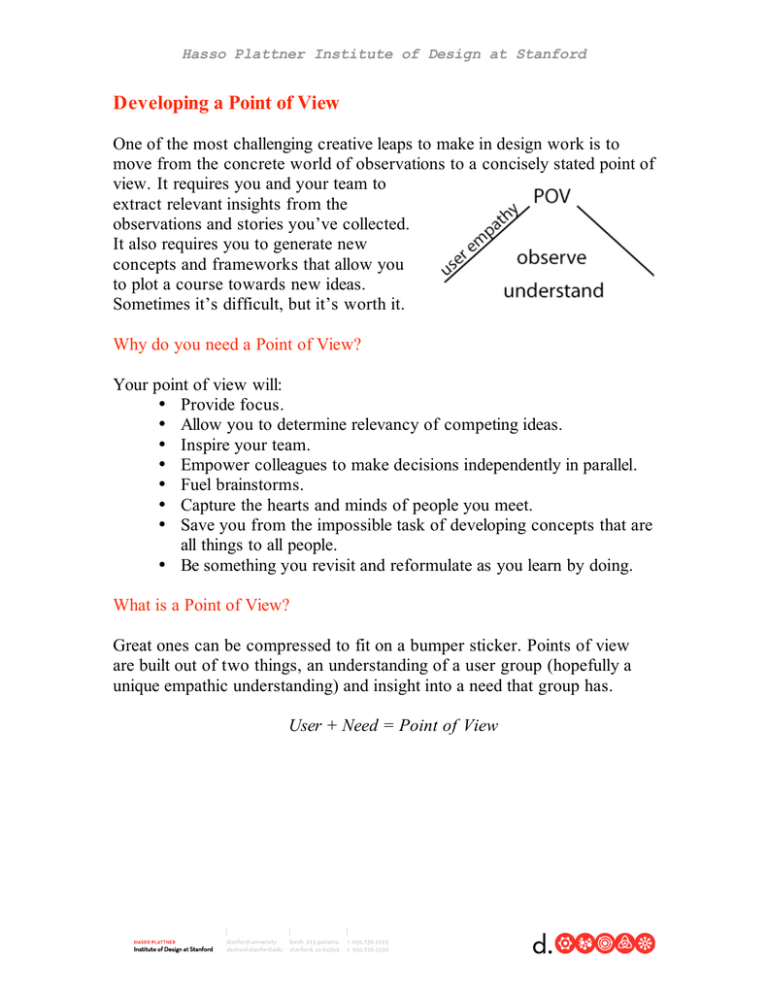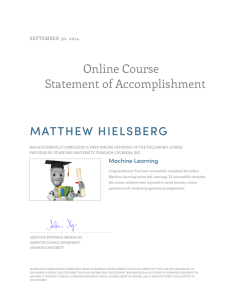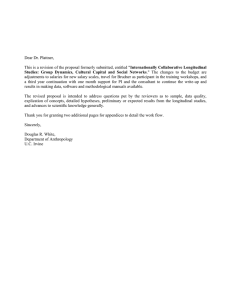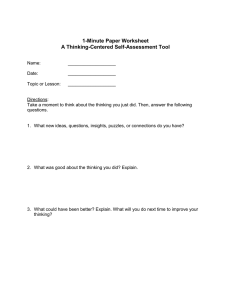Developing a Point of View
advertisement

Hasso Plattner Institute of Design at Stanford Developing a Point of View One of the most challenging creative leaps to make in design work is to move from the concrete world of observations to a concisely stated point of view. It requires you and your team to extract relevant insights from the observations and stories you’ve collected. It also requires you to generate new concepts and frameworks that allow you to plot a course towards new ideas. Sometimes it’s difficult, but it’s worth it. Why do you need a Point of View? Your point of view will: • Provide focus. • Allow you to determine relevancy of competing ideas. • Inspire your team. • Empower colleagues to make decisions independently in parallel. • Fuel brainstorms. • Capture the hearts and minds of people you meet. • Save you from the impossible task of developing concepts that are all things to all people. • Be something you revisit and reformulate as you learn by doing. What is a Point of View? Great ones can be compressed to fit on a bumper sticker. Points of view are built out of two things, an understanding of a user group (hopefully a unique empathic understanding) and insight into a need that group has. User + Need = Point of View Hasso Plattner Institute of Design at Stanford How do I get a Point of View? Tools There’s no magic knife to cut through your dense web of observations and insights (it is dense, isn’t it?) and allow you to leap straight to a wellformulated point of view. The following tools have proven useful along the way. We break them up into two types: focusing and flaring. Focusing tools help you narrow your field of view. Flaring tools expand your field of view generating new concepts and frameworks that deepen your thinking. This is by no means a comprehensive list. Pick a tool. Apply it. Learn something. See which ones work for you and your team. Repeat. Invent a new tool... Flaring Space Saturation: Get it all out in the open: write post its, tell stories, share artifacts. Whatever it takes. Get it out and get it visual. Create a space where you are immersed in the observation, artifacts and stories. (We always start with this one.) Powers of 10: Change your perspective. Back up ten steps. Let’s say you were looking at track shoes for scholastic athletes. What does the track look like? Other shoes at the event? The stadium? The town? The weather? Now move closer. Describe the feet. The toes. The left big toe. The physical shoe/skin interface. The chemical shoe/skin interface. Find your zoom button. Ride it. Mapping: Create diagrams that capture multiple observations. There are many kinds. • Journey (experience vs. time): Map the user; map their footsteps over time as they have an experience. • Spatial (presence vs. space): Where does the experience exist in space? Hasso Plattner Institute of Design at Stanford Draw the floor plan. Add in user pathways. Combines well with Powers of Ten. • 2x2: Pick two parameters and map them against each other. You might place coffee drinkers on a matrix of passion for coffee vs. socioeconomic status. How about mood vs. # cups per day. Look for obvious groupings. If everything ends up in one quadrant you might need new axis. If there’s an empty quadrant, you might have found an opportunity. (We mapped POV tool function vs. speed in the diagram on the previous page. Where can you innovate?) Play: Focus your attention on one/several project elements. Do something fun with them. Involve some members of your team. (Role Play is a good example – note the nuances and ideas that come from this) Focusing Grouping: Blur your eyes, fuzz your mind, and find the patterns. Now put the images and artifacts together that way and take a photo. Now develop a new set of “buckets” and do it again. You’re guaranteed to get somewhere, or get a headache. Composite Characters: Who is that new user your are defining? Create imaginary character profiles that combine your observations and understanding so far. Get creative, and be specific. Give them names. How old? Hometown? Where do they go on vacation? What’s the last book they read? What kind of car do they drive? Combine stories from your observations. Draw out the characters to the greatest depth that your observations and understanding allow – this depth of understanding is what will make your process stronger going forward. Now your team has imaginary friends. Include them in your design process. Insights from Observations: Draw conclusions (or postulate some) from multiple observations. (10 observation distilled into one). Directives from Insights: Synthesize insights into directives. Take your insights to the next level and put them in the form of an action. This is getting very close to a Point of View. Hasso Plattner Institute of Design at Stanford How Do you Know What To Do Next? The Big Picture Most teams are handed a Point of View or a Problem Statement and never look back. We’re devoted to the idea (bordering on religion) that the understand and observe phases where the seeds of great new ideas are to be found. You know you’re done with the observe phase when you have your Point of View. It’s the compass heading you will follow to drive your design process as you visualize solutions. UNDERSTAND OBSERVE VISUALIZE AND PREDICT EVALUATE AND REFINE IMPLEMENT relevant technologies, competitive environments, forces for change users of existing products and new prototypes innovation opportunities as mockups and prototypes with user testing and iterations engineering, design and manufacturing, marketing, communications, sales, support and service Hasso Plattner Institute of Design at Stanford How to Think Bigger What’s the difference between an incremental improvement and a big idea? It’s the thinking behind it. The Abstraction Trajectory is a framework for thinking about the scope of new ideas. The value of knowing where you are on the curve, is knowing what design deliverables come next. • Powerful ideas take root in observations about the real world. • The higher you go the farther you get. • It’s easy to mistake the “x-axis” for time. Your POV is Getting Good When... • You land somewhere you’ve never been before. • Someone gives you a high five for moving a post-it note. • Your team is speaking its own language. • You understand ordinary things in new ways. • You’re dealing with implicit needs rather than explicit problems. • You can’t sleep at night because of the opportunity you have found is so exciting…




